13 Best elearning software for 2024

For organizations looking to improve the skills and knowledge of their employees, elearning software are highly valuable. Apart from being cost-efficient, adaptable, and customizable, these tools allow you to train your teams anytime, anywhere.
In this article, we’ll cover various elearning software that can help you build a high-performing team. We’ll look at the features that make them unique and ideal based on your needs.
What is the meaning of elearning software?
Elearning software refers to computer programs and applications that support online learning and education. These software solutions are developed to deliver educational content, training materials, and interactive experiences through digital platforms.
Elearning software can be used in various contexts, including schools, universities, corporate training, professional development, and personal skill enhancement. Key features of elearning software may include:
- Content delivery: Elearning software offers a platform for delivering training content in various formats, such as text, multimedia presentations, videos, and interactive modules.
- Assessment and evaluation: Many elearning tools include features for creating assessments, quizzes, and exams to evaluate learners' understanding and progress. These assessments can be automated, giving instant feedback to learners.
- Collaboration and communication: Elearning platforms include tools for communication and collaboration among learners and instructors. This can involve discussion forums, messaging systems, and collaborative projects.
- Tracking and reporting: Elearning software offers tracking mechanisms to monitor learners' progress and generate reports on their performance. This data helps instructors and administrators assess the effectiveness of the educational materials.
- Mobile compatibility: Many elearning solutions are designed to be accessible on various devices, including desktop computers, laptops, tablets, and smartphones. This flexibility allows learners to access educational materials at their convenience.
- Learning Management System (LMS): Elearning software is often part of a broader system known as an LMS. An LMS has a centralized platform for managing, delivering, and tracking training content and activities.
Here are the best elearning software that offers scalable, flexible, and accessible solutions for learners and educators alike.
1. EdApp
As one of the best elearning software on the market, EdApp comes with a drag-and-drop creator tool and a user-friendly interface where you can easily build visually appealing courses. It allows you to incorporate multimedia elements such as images, videos, audio recordings, and interactive quizzes to enhance the learning experience for your teams.
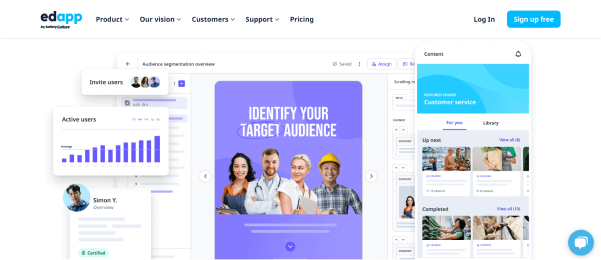
The platform also offers additional features, such as discussion forums and video conferencing, to promote social learning. But the benefits of EdApp don’t stop there. It even has robust analytics and tracking features, so you can get insights into your team’s training progress and engagement.
EdApp’s fully customizable course library, which is full of top-notch content, is another one of its strongest features. There are more than 30 distinct categories in this free library of training courses, so no matter what sector you work in, EdApp’s got everything you need!
Plus, with its AI Create feature, you’ll never be at a loss for creating course content. All you need is a topic or keyword, and this game-changing technology can generate a full course for you, complete with quizzes and interactive elements.
Cost: Free
Rating: 4.7/5
Best for: All-in-one elearning software for teams
Pros:
- User-friendly drag-and-drop creator tool
- Discussion forums and video conferencing
- Robust analytics and tracking
- Fully customizable course library
- Innovative AI course creator
Cons:
- Bulk induction transfer completion takes time
- No projected dates for course releases
Join EdApp for free and start using one of the best elearning software on the market!
2. Raven360
Raven360 is an elearning authoring software that delivers personalized training experiences. It allows companies to build their courses using its authoring tools. If you already have training materials, you can upload and convert them into dynamic elearning content. It supports blended learning, video conferencing, and gamification. One thing it’s lacking, though, is a built-in content editor.
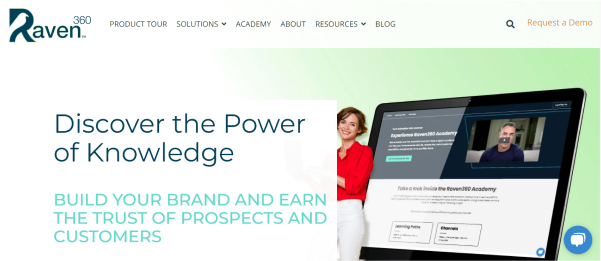
Cost: Contact Raven360
Rating: 4.6/5
Best for: Personalized training experiences
Pros:
- Authoring tools for building dynamic content
- Blended and social learning experiences
- Gamification
Cons:
- No built-in content editor
- User interface needs significant improvement
3. HireRoad
HireRoad is an open-source eLearning LMS that’s quick and easy to set up. The platform uses a variety of teaching methods to accommodate all sorts of learning styles. It has a lot of different options, so you can implement your learning plan in any way you choose, although having too many options may be intimidating for some.
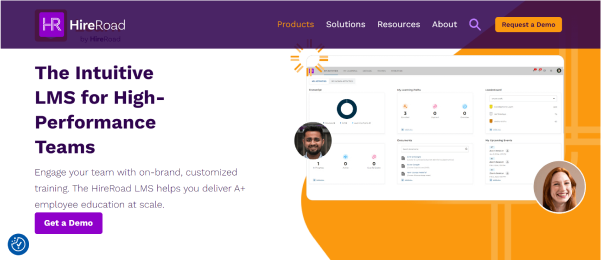
Cost: Contact HireRoad
Rating: 4.6/5
Best for: Personalized learning approach
Pros:
- Open-source elearning
- Convenient setup
- Accommodating to various learning styles
Cons:
- Possibly overwhelming and difficult to keep up with
- Reports of lost data
4. isEazy
isEazy is a cloud-based computer learning software that lets you create interactive elearning courses. It offers many interactive components, including quizzes, templates, gamification, and videos.
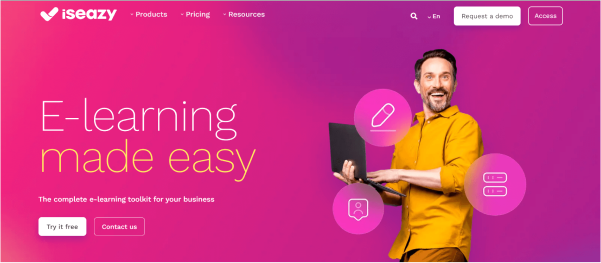
One thing it lacks, though, is PowerPoint conversion. You still have to manually recreate the content on this platform even if you already have your training materials stored in PPT files.
Cost: Contact isEazy
Rating: 4.5/5
Best for: Cloud-based online learning
Pros:
- Interactive course creation
- Engaging gamification templates and elements
- Multimedia content integration
Cons:
- No PowerPoint conversion
- Lacks slides timeline
5. GoSkills
GoSkills is an elearning platform that stands out for its specialized focus on offering high-quality courses in essential business skills. With a diverse range of courses, GoSkills caters to professionals seeking to enhance their workplace proficiency. The elearning software employs a user-friendly interface, offering bite-sized lessons, interactive quizzes, and real-world projects to guarantee practical skill development.
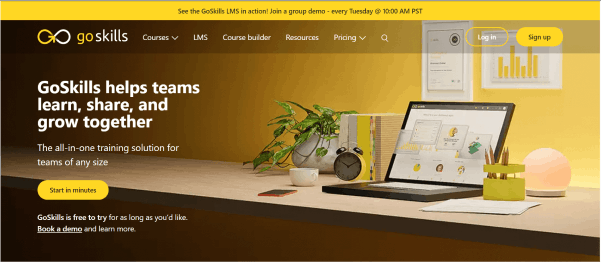
Cost: Starts at 8 USD monthly per user
Rating: 4.4/5
Best for: Professional upskilling for individuals and businesses
Pros:
- High-quality business-related courses
- User-friendly interface
- Interactive microlessons with practical skill development
Cons:
- Not suitable for big companies
- Course navigation needs improvement
6. Chamilo
Chamilo is another great elearning software development program. It’s a popular choice with business organizations and educational institutions as an open-source project where anyone’s free to contribute to its growth.

This platform has most of the features you need for an LMS, though some users complain about random bugs in the software, which can take some time to fix.
Cost: Contact Chamilo
Rating: 4.4/5
Best for: Business organizations and educational institutions
Pros:
- Open-source elearning software
- General LMS features
Cons:
- Software bugs take time to resolve
7. Open edX
Open edX is an elearning software solution that runs courses on edX, a popular elearning site for university courses. Here, course authors can build their own tools to extend the platform. This lets anyone make fully customized courses. It also has a big community that supports it, so it’s easy to find answers to questions.
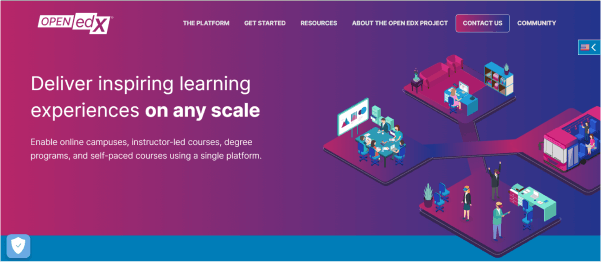
Cost: Contact Open edX
Rating: 4.2/5
Best for: Academic learning and course creation
Pros:
- edX integration
- Open-source course authoring
- Generous community support
Cons:
- Not user-friendly for beginners
- Does not have the usual LMS features
8. Totara Learn
Totara Learn is an elearning software solution that’s capable of supporting over one million users through its enterprise. It’s full of all the standard LMS features, including built-in course authoring, mobile learning, gamification, and SCORM compliance. It doesn’t have video conferencing, though, and lacks a bunch of social and peer learning features.
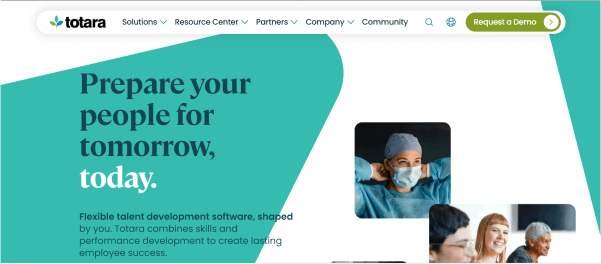
Cost: Contact Totara Learn
Rating: 3.9/5
Best for: Small- to large-scale enterprise learning
Pros:
- Built-in course authoring
- Flexible mobile learning
- Interactive gamification features
Cons:
- Lacks social learning features
- Outdated UI
9. ATutor
ATutor is geared towards training that gives instructors the ability to create and distribute elearning content. It also has built-in features like messaging, social networking, and communication tools, along with assistive technology for learners with different abilities.
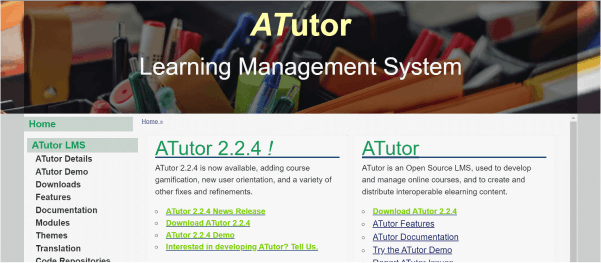
The platform’s free but it’s limited when it comes to creating beautiful and interactive lessons, so it’s suitable if you’re looking for a more basic platform.
Cost: Contact ATutor
Rating: 4/5
Best for: Simple-looking courses and lessons
Pros:
- Elearning content creation and distribution
- Strong communication features
- Assistive technology
Cons:
- Lack of course creation features
- Complicated setup
10. Forma LMS
Forma LMS is an open-source elearning software that stands out for its flexibility and adaptability. It offers a customizable platform to create, deliver, and manage training programs.
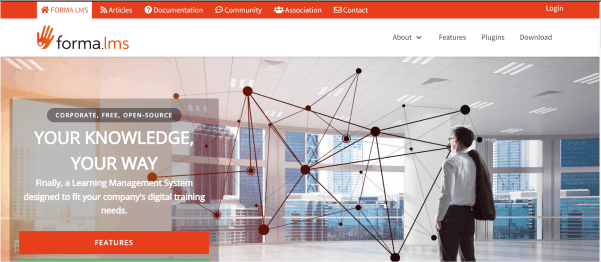
Its open-source nature allows users to tailor the platform to their needs, making it a versatile solution for a wide range of industries. Plus, the platform supports social learning, collaborative activities, and mobile accessibility for a dynamic and engaging learning experience.
Cost: Contact Forma LMS
Rating: 4.6/5
Best for: Versatile elearning solution for various industries
Pros:
- Social and collaborative learning
- Convenient mobile accessibility
- Dynamic learning experience
Cons:
- Limited language integrations
- Limited video conferencing integrations
11. Degreed
Degreed is a learning experience platform that’s designed to curate and personalize learning paths for individuals within organizations. It uses content from various sources, including online courses, articles, videos, and books, to create a comprehensive learning ecosystem.
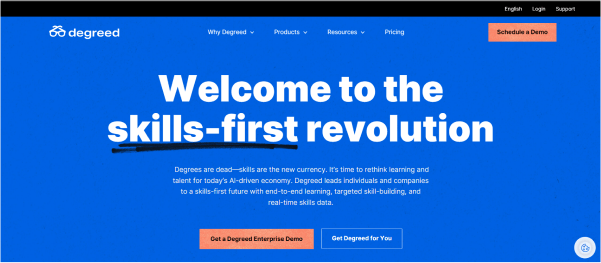
Degreed also uses AI and data analytics to offer personalized recommendations based on users' interests and skill gaps, to support continuous learning and professional development.
Cost: Contact Degreed
Rating: 3.9/5
Best for: Individual and organizational learning
Pros:
- Personalized learning paths
- Comprehensive learning ecosystem
- AI- and data-based recommendations
Cons:
- Not so intuitive UX
- Higher fees apply
12. 360Learning
360Learning is a collaborative learning platform that prioritizes peer-to-peer interactions and social learning experiences. It empowers organizations to create and deliver interactive courses with a focus on engagement and knowledge retention.
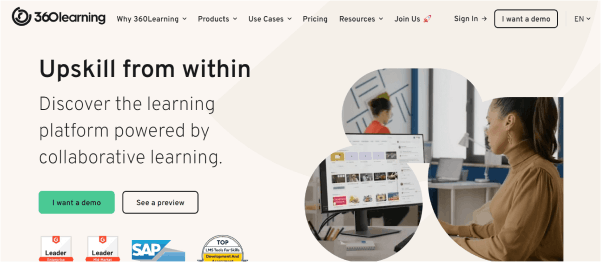
The platform also allows users to co-create content, fostering a sense of community and shared expertise. With these features, 360Learning facilitates a dynamic learning environment for corporate training.
Cost: Starts at 8 USD monthly per user
Rating: 4.6/5
Best for: Social and peer-to-peer learning
Pros:
- Collaborative learning features
- Interactive and engaging courses
- Content co-creation
Cons:
- Slow to correct bugs
- Platform upgrades during business hours
13. LearnWorlds
LearnWorlds stands out as an elearning platform that empowers individuals and businesses to create and sell their online courses. With a strong emphasis on customization and branding, the platform lets course creators design engaging and interactive content, including video lectures, quizzes, and discussions. It also supports social learning features, allowing communities to form around specific courses.
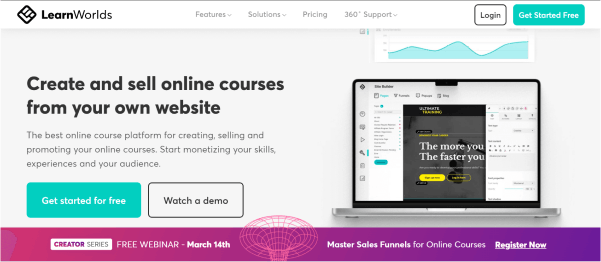
Cost: Starts at 24 USD monthly
Rating: 4.7/5
Best for: Creating and selling online courses
Pros:
- Customization and branding options
- Engaging and interactive content
- Video lectures, quizzes, and discussions
Cons:
- Lack of student authentication
Advantages of elearning
While there are numerous reasons to incorporate elearning into your enterprise, a few of them include:
- Saving company money – Using elearning means fewer in-person instructional hours and lets educators focus on teaching higher-order thinking skills rather than presenting content.
- Improved retention of learning material – Spaced repetition allows for learning to be reinforced at ideal times so the learners won’t forget material from previous lessons. Elearning is ideal for this because of its use of AI for training.
- Flexible learning times – Busy learners can benefit from the opportunity to learn on their own time because employees often have many responsibilities to handle during the day.
With more and more people switching to elearning, which platform do you think you’d like to use in your elearning project for the best learning experience?
Author
Donna Dane
Donna is an elearning content writer for EdApp, a mobile-based microlearning platform designed for today's digital training needs. When she's not writing web articles, she writes lines of code or songs or anything food-related.
